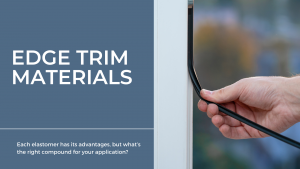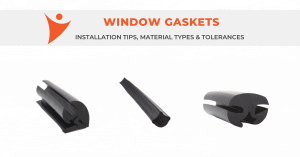Foam rubber properties include compression set and stress relaxation. Learn what these material properties are, why they matter, and how to select the right foam rubber for your application.
Foam rubber gaskets provide reliable sealing, cushioning, and insulation in a variety of applications. Because you can choose profiles made from many different types of foam, compound selection can be a complex task. In addition to material properties and compliance with industry or regulatory standards, there are other factors to consider. For example, long-term sealing under constant compression may be required.
Let’s take a look at two key foam rubber properties: compression set and stress relaxation. We’ll also look at some common foam rubber materials. Elasto Proxy isn’t a rubber compounder, but we want you to understand how the rubber that’s used can affect long-term sealing performance. We keep hundreds of rubber profiles in stock, but which one is right for you?
What is compression set?
Compression set or C-set resistance describes the ability of a rubber material to return to its original thickness after a compressive load, such as from pushing or pressing, is released. It’s important to recognize that most elastomers will not regain all of their initial thickness after a constant load is released. If the rubber loses only a small percentage of its initial thickness, the material is said to have good compression set resistance. Conversely, elastomers that lose much of their initial thickness are said to have poor C-set resistance.
In terms of foam rubber properties, it’s also important to understand how time and temperature affect C-set. To simulate accelerated aging, rubber compounders test materials at both an elevated temperature and room temperature. Typically, the elevated temperature is 70°C, a threshold that’s higher than room temperature (23°C), but one that doesn’t exceed the upper service temperature for the foam rubber. By considering C-set in terms of time and temperature, you can choose the right compound for your application.
Some silicone foams and urethane foams have good compression set when subjected to standard test conditions of 50% compression for 22 hours at 23° C and at 70° C. By contrast, a neoprene/EPDM blend may have a poor C-set at room temperature and a worse C-set at 70° C. In this case, blending two materials does not create a compound with superior compression resistance. Individually though, both neoprene foam and EPDM foam have better compression set resistance than a neoprene/EPDM blend.
What is stress relaxation?
Stress relaxation also helps to determine a foam rubber gasket’s long-term sealing effectiveness. Also known as force relaxation, stress relaxation describes a rubber’s tendency to lose force deflection over time while under continuous loads. As a rule, most of a material’s stress relaxation occurs during the first few hours of compression. Afterwards, higher-performing materials lose less force over time. Test conditions for stress relaxation typically involve 25% material compression over 60 hours.
Let’s consider the stress relaxation curves for some common types of foam rubber use in sponge profiles. EPDM foam retains approximately half of its initial force after compression, and then loses another 20% over the next 10 hours. After that, there isn’t much more change with EPDM foam. By contrast, vinyl nitride foam has steep initial losses and then gradually loses more force deflection over time. Neoprene/EDPM blends drop precipitously in the first 10 hours, and then decrease gradually thereafter. By understanding foam rubber properties, you can select the right compound for your application.
Who understands foam rubber properties and makes custom gaskets?
Sealing challenges are complex and no two applications are the same. Do you need foam rubber gaskets for constant compressive loads? How well do you understand all of the application requirements? Plus, what about seal geometry, industry standards, and vendor selection? They’re all important to consider, too. To make the right decisions, you need a resource you can trust from a partner with experience.










